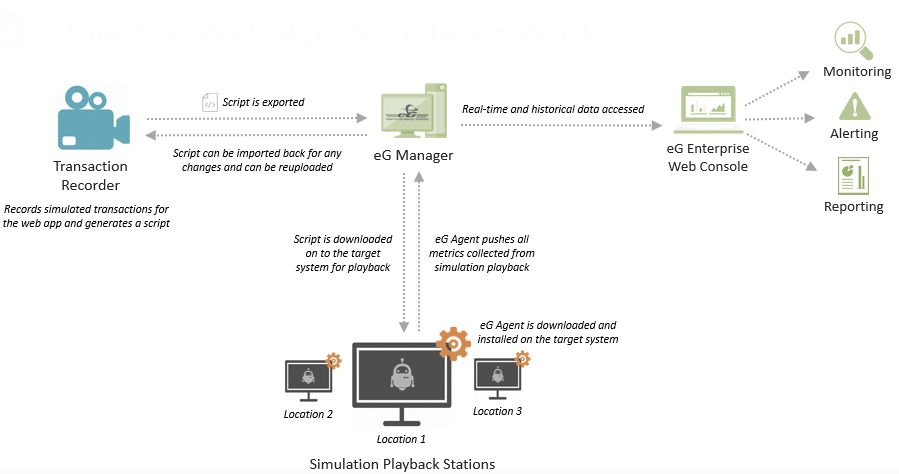How does the Web App Simulator Work?
Typically, the first step in using the Web App Simulator is to record a sequence of user activities when accessing the web site(s) to be monitored. For this purpose, eG Enterprise offers a purpose-built, in house Web App Simulation Recorder. The end result of the recording process is a script that can be later played back by the Web App Simulation Playback Engine to emulate the transaction activity.

Figure 1 : How the Web App Simulator works
The recorded script not only includes the sequence of transactions necessary to emulate the transaction activity , but also has information on those transactions - each transaction corresponds to a single user interaction (e.g., logging in, adding to shopping cart, etc).
The Web App Simulation Playback Engine is an executable that is bundled along the eG agent and is installed on remote locations (playback stations) from where the simulation playback happens. The recorded script is played back on a dedicated system by the Web App Simulation Playback Engine, and the results are reported as availability and response time measures for the overall playback activity. In addition, response times of each of the transactions involved can be obtained so as to assist the IT service manager in pin-pointing which of the transactions of the multi-step user interaction with the web application could be causing a slow-down of the overall website /web application.
The eG agent is provided with the location of the recorded script that it has to execute to emulate a user activity. Based on the pre-specified frequency of the test, the agent executes the script, analyzes the script results, and reports availability and response time information to the eG manager. The eG manager receives these web app simulation reports and correlates them in real-time with critical in-depth resource usage and server-side processing metrics that it receives from the other agents, to report on potential bottlenecks in the target IT infrastructure.
The eG external agent implements the integration with the Web App Simulation Recorder. Since the recorder requires a dedicated system to operate on, an external agent can either perform client simulation tests or the other eG protocol simulation tests, but not both. When adding a new external agent, depending on the eG license available, the administrator can specify whether the agent must be allowed to perform client session simulation activity or not.
As stated earlier, a dedicated eG external agent drives the web app simulation. This agent periodically runs a Simulated Web Transactions test that emulates the entire process of a user logging into a website and performing a transaction. Since the test is what performs the simulation, let's call it the Web App Simulator. To perform this simulation, the Web App Simulation Recorder has to be configured with the URL of the target website.
There are a certain pre-requisites that need to be fulfilled prior to recording the transactions. For this, refer to Pre-requisites for Using Web App Simulator
To know how to record the transaction, refer toHow to Record a Transaction?
Once the sequence of transactions are recorded as a script, it runs at the configured frequency. Every time it runs, it simulates the sequence of transactions recorded in the script and collects the required metrics.
The metrics so collected are reported to the eG manager. The manager captures these metrics into a Web App Simulation component and presents them in the eG monitoring console for analysis. Refer to Analyzing the Simulation Results